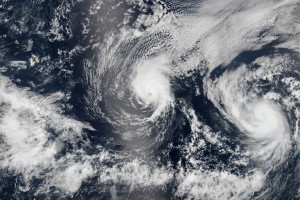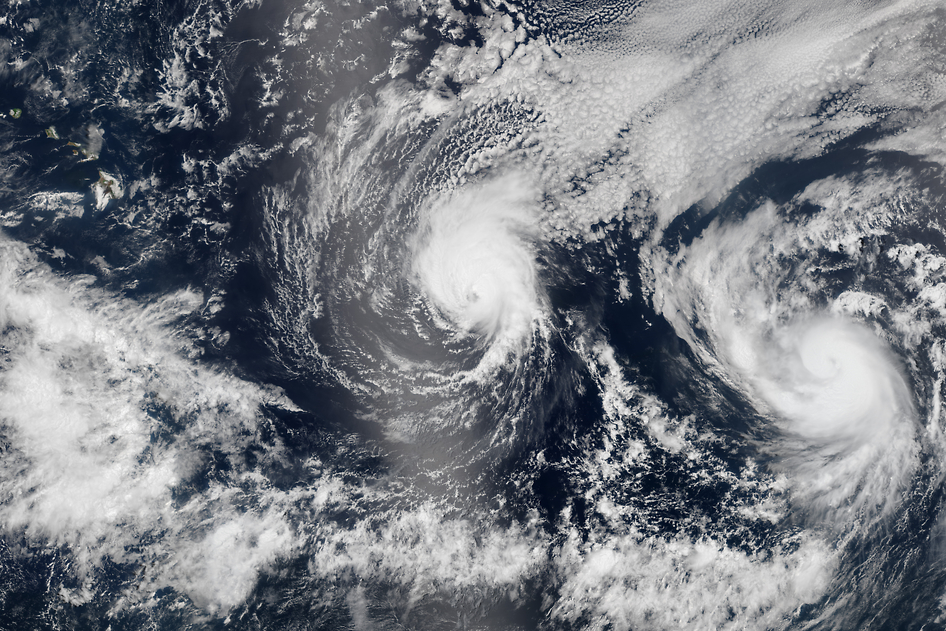For a few minutes last Wednesday, there weren’t any hurricanes, cyclones, typhoons or tropical storms anywhere in the world.
The respite didn’t last long. Thursday morning, the U.S. Navy and Air Force’s Joint Typhoon Warning Center, along with the Indian Meteorological Department, began tracking Megh, a cyclonic storm in the Arabian Sea.
Apparently, there were also a few hours between Tropical Storm Olaf, which died on Oct. 27, and Tropical Cyclone Chapala, which began on Oct. 28, said Jeff Masters, co-founder of Weather Underground in Ann Arbor, Michigan.
“Before that, there was a TC-free few hours on September 15, and another period on September 12-13,” Masters said.
It’s been a big year for hurricanes, typhoons and cyclones, which are just different names for the same kind of storm.
According to a measurement called ACE, or accumulated cyclone energy, this has been the second-most active year on record, bested only by 1992, said Phil Klotzbach, lead author of the Colorado State University seasonal hurricane forecast.
Energy Score
“The ACE is about 800 right now and it’s surpassed every year but one,” Klotzbach said.
Globally, there have been nine Category 5 storms, the strongest on the five-step Saffir-Simpson scale, three fewer than the record set in 1997, Masters said.
An all-time high of 23 for Category 4 and 5 storms was set this year, which beats the old mark of 18 set in 1997 and 2004, according to Klotzbach.
The intensity “is what will make this season notable,” he said.
Nowhere is that intensity more on display than in the Pacific. Of those 23 Category 4 and 5 storms, 21 were in the Pacific, meaning the basin broke the world record all by itself.

This is in part because the Pacific has been warm. An El Nino, when sea surface temperatures warm, is currently under way in the equatorial Pacific and that has contributed to this year’s activity.
Development Causes
However, that isn’t the only thing spurring on this year’s storm development. Another phenomenon called the Pacific Meridional Mode has helped boost water temperatures from Hawaii to California, Klotzbach said.
The two warm phases don’t always line up, but this year they did. That has kept the waters around Hawaii active, as well as allowing storms to maintain strength and structure far north, Masters said.
This is one of two high points for storms in that part of the world, Masters said. Tropical systems tend to form in the Arabian Sea in May and June and then again in October and November.
The monsoon, which comes during the summer months, creates such high wind shear it is hard for storms to form in-between, Masters said.
While neither Masters or Klotzbach thinks the budding storm there will amount to a very strong system, it’s keeping this year’s system count going.
And if that wasn’t enough, the U.S. National Hurricane Center is tracking two potential patches of thunderstorms in the Atlantic that have some chance, albeit low, of developing in the next five days.
Globally, “I don’t think we’re done even though we are getting to the last gasp of hurricane season,” Masters said.
In the Atlantic and eastern Pacific, that last day is Nov. 30.
Was this article valuable?
Here are more articles you may enjoy.


 LA Wildfires Had Little Impact on Reinsurer Risk Appetite During April Renewals
LA Wildfires Had Little Impact on Reinsurer Risk Appetite During April Renewals  UAW Joins Critics Slamming RFK Jr.’s Cuts to Worker Safety Unit
UAW Joins Critics Slamming RFK Jr.’s Cuts to Worker Safety Unit  Trump’s Tariffs Send Deliberate Shock to Heart of Global Economy
Trump’s Tariffs Send Deliberate Shock to Heart of Global Economy  Report Highlights Louisiana’s Tort System as Barrier to Social Mobility
Report Highlights Louisiana’s Tort System as Barrier to Social Mobility 